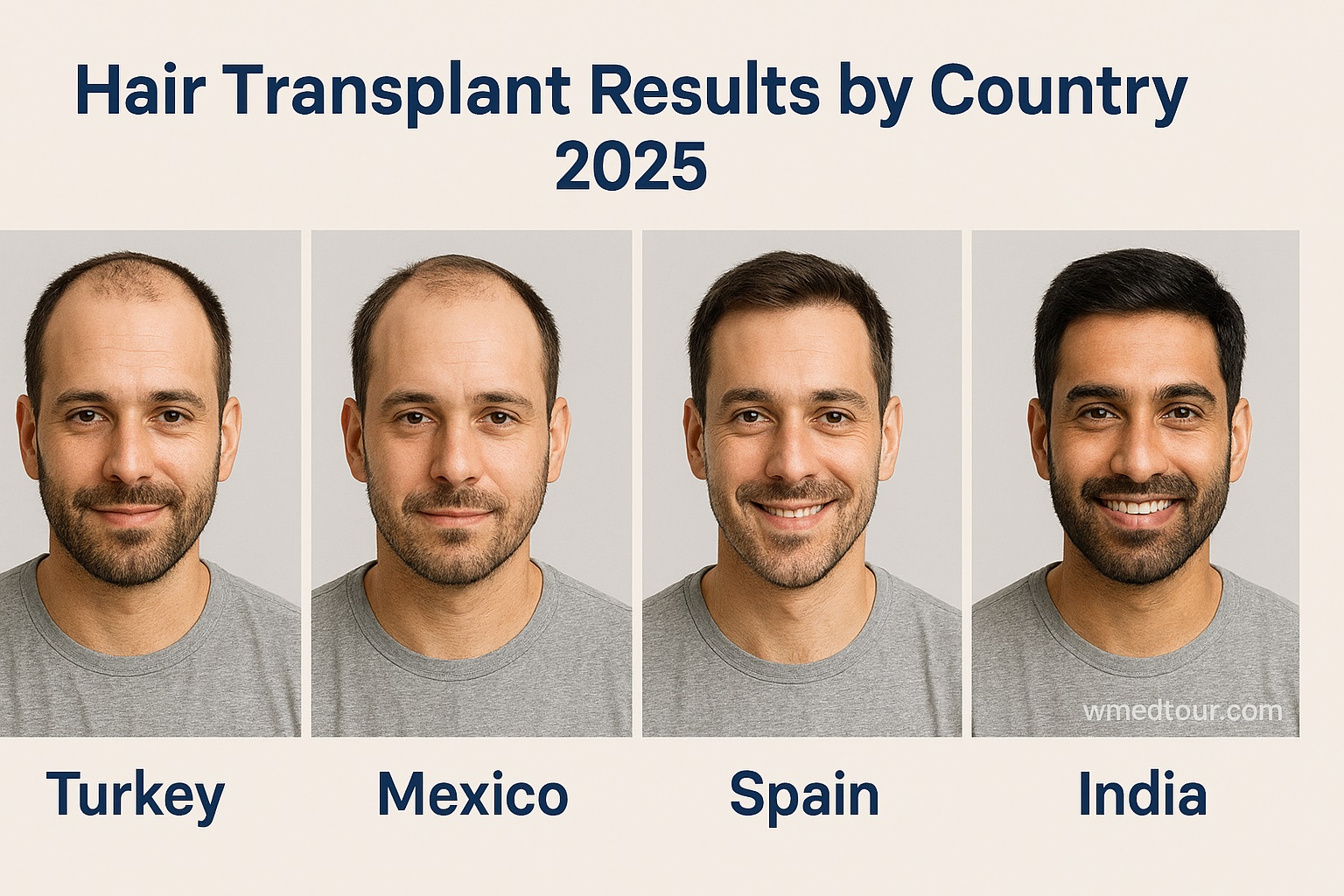Hair Transplant Results by Country 2025: Your Global Guide
Executive Summary: Key Takeaways for 2025
The quest for permanent hair restoration has made hair transplantation a global phenomenon, with the market projected to surge past $10.58 billion in 2025 (Source 1.1). However, achieving superior, natural-looking **Hair Transplant Results by Country 2025** requires navigating a complex landscape of cost, quality, and regulation. Here’s what you need to know:
- Turkey and Iran Dominate Value: These countries offer exceptional value, often packaging the FUE or DHI procedure with accommodation and transfers, significantly lowering the overall cost compared to the West. Iran, in particular, has become an aesthetic powerhouse.
- Quality is Tied to the Surgeon, Not the Country: Whether you choose Berlin or Istanbul, the primary factor in a successful outcome (90-95% graft survival) remains the surgeon’s skill and ethical practice, according to data summarized from the ISHRS 2025 Practice Census Report.
- The FUE/DHI Edge: Follicular Unit Extraction (FUE) and its refinement, Direct Hair Implantation (DHI), are the undisputed standard, accounting for the vast majority of procedures globally. Read more about FUE vs. DHI vs. FUT success rates.
- Mitigate Risk: The rise of ‘black market’ clinics—where unlicensed staff perform surgery—is a severe global issue (Source 1.4). Due diligence is more critical now than ever.
Understanding the Global Hair Restoration Landscape
For millions worldwide, hair restoration is a deeply personal journey, offering a significant boost in confidence and professional competitiveness. But with so many options, how do you determine where to find the absolute best **Hair Transplant Results by Country 2025**? This guide cuts through the marketing noise to analyze the key players in medical tourism, offering an authoritative, empathetic, and jargon-free perspective on what truly drives success.
The global hair restoration field is marked by intense competition and innovation. Consequently, patients are no longer limited to their local clinics. They travel, often internationally, to find the perfect blend of expertise, technology, and cost efficiency. We will explore how different countries meet these demands, ensuring you make an informed decision about your long-term results.
Who is This For?
This comprehensive guide is tailored for several key audiences:
- The Medical Tourist: You are cost-conscious and willing to travel abroad to access world-class care at a fraction of the domestic price. You are looking for a reliable roadmap to find the best country for a hair transplant in 2025.
- The Quality Seeker: Your primary concern is the naturalness and density of the outcome, regardless of the price. You need detailed information on techniques, surgeon credentials, and clinical standards.
- The Professional Researcher: You are a medical professional, journalist, or industry analyst seeking credible, up-to-date data on market trends, popular techniques (like modern hair transplant techniques), and the regulatory environment.
- The First-Time Patient: You are just beginning your research, potentially dealing with hair loss for the first time, and require an easy-to-understand breakdown of the entire process, including the basics of medical tourism.
Global Breakdown: The Top Hair Transplant Destinations in 2025
As the market evolves, certain countries have solidified their reputations, each offering a unique value proposition. Ultimately, the quality of your **Hair Transplant Results by Country 2025** will depend on a careful analysis of the following key destinations.
Turkey: The Global Volume Leader
Turkey, specifically Istanbul, remains the undisputed capital of global hair restoration. This dominance is not accidental; it’s the result of decades of investment in high-volume, cost-effective service models. Consequently, the Turkish model delivers incredible value, which explains its continued popularity among patients seeking high-density results.
Pros and Cons of Hair Transplants in Turkey
The Challenges (Cons)
- Regulatory Oversight: The high volume has unfortunately led to a corresponding rise in unlicensed, low-quality operations, often referred to as ‘black market’ clinics. Thorough vetting of clinics and doctors in Istanbul is crucial.
- Over-Harvesting Risk: Some high-volume clinics may be aggressive with extractions, risking permanent damage to the donor area.
- Delegation of Surgery: Surgeons at some budget clinics delegate the entire procedure to technicians, which can compromise the quality of the final result.
The Advantages (Pros)
- Unmatched Cost-Effectiveness: All-inclusive packages drastically reduce the final hair transplant cost.
- High Surgeon Specialization: Due to the sheer volume of procedures, many Turkish surgeons specialize solely in hair transplantation, honing their FUE and DHI skills.
- Advanced Technique Adoption: Turkish clinics were early adopters and perfecters of the FUE and DHI methods.
For those considering Turkey, understanding Turkey’s medical travel regulations is a smart first step.
Iran: The Emerging Aesthetic Powerhouse
Iran is rapidly securing its position as a major contender for superior **Hair Transplant Results by Country 2025**. Already renowned for cosmetic procedures, particularly rhinoplasty, the country has channeled its medical expertise into hair restoration. Iran offers an excellent balance of highly-skilled surgeons and exceptionally competitive pricing, often undercutting Turkish and Western markets substantially. The quality of aftercare and patient services in major cities like Tehran and Mashhad is world-class.
Pros and Cons of Hair Transplants in Iran
The Challenges (Cons)
- Travel Logistics: Visa requirements and travel advisories can be more complex for some international travelers compared to European destinations.
- Less Marketing Visibility: Clinics, while highly skilled, have historically had less international marketing presence than Turkish ones, making the initial research phase harder.
The Advantages (Pros)
- Unmatched Affordability: Iran consistently offers some of the lowest costs globally for high-quality FUE hair transplant procedures.
- High Technical Skill: Iranian surgeons are highly trained in detailed cosmetic procedures, leading to meticulous hairline design and natural density.
- Government Support: There is growing governmental support for medical tourism, which contributes to higher regulatory standards and better patient safety compared to some high-volume markets. Understand Iran’s medical travel regulations here.
United States & Western Europe: The Premium Standard
In countries like the US, UK, and Germany, the cost is significantly higher, but the procedures are performed under strict regulation. Patients here prioritize legal protection and localized aftercare. While results can be exceptional, they often involve a financial outlay three to five times greater than in major medical tourism hubs.
Pros and Cons of Hair Transplants in the West
The Challenges (Cons)
- Prohibitive Cost: The high price tag puts the procedure out of reach for many, limiting its accessibility.
- Slower Adoption of High-Volume Techniques: Some top-tier clinics may operate at lower volume, which can mean less repetition in FUE/DHI than high-volume centers abroad.
The Advantages (Pros)
- Legal Recourse: Patients have strong legal and medical regulatory frameworks for protection.
- In-Person Aftercare: Easy access to the operating surgeon for immediate follow-up and long-term care.
- Surgeon-Driven Procedures: Less delegation of the critical extraction and implantation phases.
The Science of Success: Beyond the Country Name
Ultimately, the geographical location is secondary to the skill and ethics of the provider. The difference between adequate and amazing **Hair Transplant Results by Country 2025** hinges on a few core principles that hold true everywhere:
1. Graft Survival and Technical Expertise
Graft survival rates are the fundamental metric of success. Reputable clinics achieve rates of 90-95% (Source 2.2). This success is largely dependent on minimizing the time the grafts spend outside the body (ischemia time) and ensuring they are handled gently to avoid physical damage during extraction and implantation.
The choice of technique plays a pivotal role in this. The Follicular Unit Extraction (FUE) method—where individual follicular units are extracted—is the global standard. This technique offers minimal scarring and quicker recovery. A skilled surgeon aims for a transection rate (damage to the graft during extraction) of under 5%. The scientific integrity of the process, including the preservation fluid used, is equally important for Follicular Unit Graft Survival (Source 2.3).
2. Aesthetic Design and Density
A great result is undetectable. This comes down to the surgeon’s artistic vision. They must meticulously control three factors:
- Angle: Ensuring the transplanted hairs match the original angle of growth.
- Direction: Following the natural swirl and flow of the hair pattern.
- Density: Placing enough grafts per square centimeter to look full, avoiding a ‘see-through’ result. The DHI method often excels here, as it allows for denser packing. Learn more about FUT vs. FUE vs. DHI.
3. Avoiding the Medical Tourism Pitfalls
Medical tourism offers immense benefits, but patients must be aware of the inherent risks. The AMA Code of Ethics and CDC warnings emphasize risks like poor infection control and the difficulty of legal recourse or follow-up care if complications arise abroad (Sources 3.2, 3.5). The World Medical Association Statement (Source 3.6) calls for ethical standards to protect patients.
Global Comparison: Hair Transplant Key Metrics 2025
To help visualize where the best value for cosmetic surgery and hair restoration lies, we’ve synthesized key data points. Note that costs are approximate for a 3,000-graft FUE procedure.
| Country/Region | Avg. Cost (3,000 Grafts) | Primary Advantage | Key Metric for 2025 | Risk Profile |
|---|---|---|---|---|
| Turkey | $2,500 – $4,500 (Often All-Inclusive) | Highest Volume & Best Value | Advanced DHI/FUE adoption & experience | High risk of ‘black market’ clinics |
| Iran | $1,800 – $3,500 | Lowest Cost for High-Quality Care | Meticulous aesthetic focus and low cost. See: Iran’s rise in plastic surgery. | Complex travel logistics |
| USA / Western Europe | $8,000 – $18,000 | Strongest Legal/Regulatory Framework | Local, accessible aftercare and highest legal protection | Low risk, but poor cost efficiency |
| UAE (Dubai) | $5,000 – $9,000 | Luxury Service & Strict Regulation | Focus on DHI and high-end patient experience. See: Dubai Hair Transplant Cost. | Low risk, high price point |
Patient Journey: Achieving Optimal Results in Iran
Case Study: Omar’s Decision for Density and Value
Patient Profile: Omar, a 32-year-old software engineer from Germany, was experiencing Norwood Scale 3 vertex thinning and a slightly receding hairline. His goal was natural density without the high Western European cost.
The Journey:
- Initial Research: Omar initially looked at Germany but found the quotes ($12,000+) too high. He shifted his focus to medical tourism hubs. After researching the high volume in Turkey and the meticulous cosmetic focus in Iran, he opted for an established clinic in Mashhad, Iran. The total cost, including flight and 3 nights of accommodation, was under $4,000.
- The Procedure: A specialized surgeon recommended 3,500 FUE grafts with DHI implanters used for the frontal hairline. The procedure took 8 hours, ensuring maximum graft viability. Omar specifically asked about the surgeon’s transection rate and verified the facility’s accreditation, following all WHO health guidelines (Source 3.1).
- Post-Op & Recovery: After a crucial check-up before his flight, Omar was diligent with the aftercare kit provided by the clinic, particularly the first 10 days.
- The Result (14 Months): At his 14-month mark, Omar achieved a dense, completely natural-looking result. The hairline seamlessly blended with the native hairs, and the vertex provided excellent coverage. He credited the surgeon’s focus on aesthetic detail and the clinic’s meticulous post-operative instructions for his success. Omar noted that the **Hair Transplant Results by Country 2025** are often a reflection of the national specialization, and Iran delivered on its reputation for cosmetic precision.
This journey highlights the fact that superb **Hair Transplant Results by Country 2025** are possible when patients conduct deep research and prioritize certified quality over mere low prices. You can also explore Tehran and Mashhad’s cosmetic reputation.
Frequently Asked Questions (FAQ)
Here are the most important and most-asked questions about hair transplant results and global travel:
Q: How do I verify a foreign surgeon’s credentials?
A: Look for membership in international bodies like the International Society of Hair Restoration Surgery (ISHRS). Also, check if they are board-certified in their home country, and ask for proof of hospital accreditation for the operating facility. This step is vital for protecting yourself from the Global Hair Care Market Trend (Source 1.6) of uncertified clinics.
Q: Is FUE or DHI better for graft survival?
A: When performed by an experienced surgeon, both techniques have comparable, excellent survival rates (90%+). DHI, or Direct Hair Implantation, uses a specialized tool that minimizes the graft’s time outside the body, offering theoretical benefits in survival, especially when done in high-quality facilities like the ones mentioned in our Turkish cost guide.
Q: Can I combine a hair transplant with other procedures?
A: Yes, many patients combine their hair restoration trip with other treatments, especially aesthetic surgeries in Turkey or dental work. Always discuss this with your surgeon to ensure it doesn’t compromise the safety or recovery of the primary hair procedure.
Q: What happens if the transplanted hair falls out after a few weeks?
A: This is called ‘shock loss’ or the ‘shedding phase’ and is a completely normal, expected part of the recovery process. The hair shaft falls out, but the transplanted follicle remains securely in the scalp and will begin to regrow around the 3-4 month mark. Do not panic; this does not mean the procedure failed.
Q: How soon can I travel back home after the procedure?
A: Most surgeons advise that you can fly home 24 to 72 hours after the surgery, provided you attend your final post-operative check-up. Flying immediately after is possible, but short layovers and protection of the graft area are essential. Check global travel regulations.
Q: What is the main cause of poor hair transplant results?
A: Poor results are overwhelmingly caused by either the lack of artistic skill in the hairline design or technical failure leading to poor graft survival, often due to improper handling, dehydration, or long out-of-body time. This frequently occurs in unethical ‘chop-shop’ clinics.
Q: Why are Asian countries like South Korea popular, and what results do they offer?
A: South Korea is a leader in aesthetic surgery, focusing on minute detail and hyper-natural results, especially hairline design tailored to specific Asian facial structures. Their focus is on premium, detailed outcomes, similar to their reputation in general cosmetic surgery.
Q: Do I need to shave my head for the transplant?
A: For FUE and DHI, the donor area must be shaved to allow for precise extraction. Some clinics offer ‘Unshaven FUE’ (U-FUE), where only the donor area is clipped in a camouflaged manner, but this is usually suitable for smaller procedures and is a more labor-intensive, costly technique. Explore hair transplant glossary terms here.
Q: Is there an age limit for a hair transplant?
A: There is generally no upper age limit, provided the patient is healthy enough for the minor surgery. The lower age limit is typically around 25, as the hair loss pattern stabilizes around this time, allowing the surgeon to plan a lifelong, natural-looking hairline.
Q: Can a hair transplant fail after 10 years?
A: The transplanted hairs themselves are permanent and genetically immune to pattern baldness. However, the native hair surrounding the transplant may continue to thin. This gives the *appearance* of the transplant failing, which is why surgeons often recommend preventative medication to maintain the surrounding native hair.
Q: What should be in my post-operative care kit?
A: A high-quality kit should include a specialized pH-neutral shampoo and lotion, antibiotics, pain medication, a neck pillow for sleeping, and clear, written instructions (ideally translated into your native language). This is crucial for successful graft healing.
Q: What is the primary ethical issue in medical tourism for hair restoration?
A: A key ethical issue is the provision of adequate aftercare. Medical decisions should be made by physicians, but the difficulty of obtaining follow-up care from the host country physician is a major concern upon returning home, as emphasized by ethical guidelines (Source 3.2).
The Final Verdict on **Hair Transplant Results by Country 2025**
The global outlook for hair restoration in 2025 is overwhelmingly positive, driven by technological advancements in FUE and DHI and competitive medical tourism markets. While Turkey continues to offer the most accessible entry point to global expertise, emerging powerhouses like **Iran** are providing an exceptional blend of affordability and cosmetic precision. Remember, the true metric for success is not the country stamped on your passport, but the certifications held by your surgeon and the quality of the aftercare you receive. The best **Hair Transplant Results by Country 2025** are those achieved through diligence, ethical practice, and world-class skill. Start your journey by finding the best fit for you.




